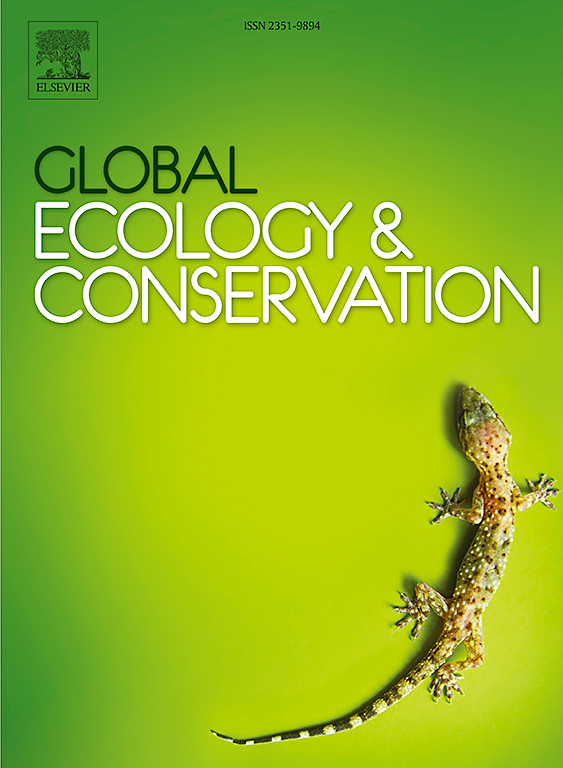Seed and bud banks respond differentially to seasonal flooding disturbance along a successional gradient in a river-connected floodplain wetland
IF 3.4
2区 环境科学与生态学
Q1 BIODIVERSITY CONSERVATION
引用次数: 0
Abstract
Soil seed banks and belowground bud banks play crucial roles in population recruitment and vegetation succession in wetlands. Successional stages and flooding disturbance influence seed and bud bank traits but have rarely been explored in floodplain wetlands. We investigated seed and bud banks species composition and density along a successional gradient from shallow water to Carex grassland in Shengjin Lake—a floodplain wetland of the Yangtze River in China—before (May 2023) and after (November 2023) flooding. The species richness of soil seed banks and species similarity with extant communities increased from shallow water to Carex grassland before and after flooding. The few species in bud banks were perennial macrophytes, namely, Carex thunbergii, Phalaris arundinacea, and Eleocharis valleculosa var. setosa. The density of soil seed banks increased from shallow water, mudflat, to Carex grassland (6980, 9438, and 18,140 seeds m-2, respectively) before flooding and significantly decreased after flooding (3174, 7608, and 10,439 seeds m-2, respectively). The density of the bud bank increased from shallow water, mudflat, to Carex grassland (0, 78, and 437 buds m-2, respectively) before flooding but significantly increased after flooding in shallow water and Carex grassland (16 and 1082 buds m-2, respectively). Our results indicated that both seed and bud banks increased across the successional gradient from shallow water to Carex grassland and responded differently to seasonal flooding except that bud banks in mudflat showed similar response trends. Therefore, vegetation restoration in floodplain wetlands should consider the interplay between seed and bud banks, successional stage, and flooding disturbance.
在河流连通的洪泛平原湿地中,种子库和芽库对季节性洪水干扰的响应是不同的
土壤种子库和地下芽库在湿地种群补充和植被演替中起着至关重要的作用。演替阶段和洪水干扰对种子库和芽库性状的影响很少在漫滩湿地进行研究。研究了盛金湖(中国长江河漫滩湿地)洪涝前(2023年5月)和洪涝后(2023年11月)种子库和芽库物种组成和密度沿浅水区到草甸的演替梯度。洪水前后土壤种子库的物种丰富度和与现有群落的物种相似性从浅水区到苔草草地呈上升趋势。芽库中以多年生大型植物为主,主要有毛茛(Carex thunbergii)、蝴蝶兰(Phalaris arundinacea)和木犀草(Eleocharis valcullosa var. setosa)。土壤种子库密度从浅水区、泥滩到草甸依次增加(分别为6980、9438和18140粒m-2),洪水后显著降低(分别为3174、7608和10439粒m-2)。淹水前浅水、泥滩、苔草草地的芽库密度分别为0、78、437个芽(m-2),淹水后浅水和苔草草地的芽库密度分别为16、1082个芽(m-2)。结果表明,从浅水区到苔草区,种子库和芽库在演替梯度上均呈增加趋势,但对季节性洪水的响应不同,滩涂区芽库的响应趋势相似。因此,河漫滩湿地植被恢复应考虑种子库与芽库之间的相互作用、演替阶段和洪水干扰等因素。
本文章由计算机程序翻译,如有差异,请以英文原文为准。
求助全文
约1分钟内获得全文
求助全文
来源期刊

Global Ecology and Conservation
Agricultural and Biological Sciences-Ecology, Evolution, Behavior and Systematics
CiteScore
8.10
自引率
5.00%
发文量
346
审稿时长
83 days
期刊介绍:
Global Ecology and Conservation is a peer-reviewed, open-access journal covering all sub-disciplines of ecological and conservation science: from theory to practice, from molecules to ecosystems, from regional to global. The fields covered include: organismal, population, community, and ecosystem ecology; physiological, evolutionary, and behavioral ecology; and conservation science.
 求助内容:
求助内容: 应助结果提醒方式:
应助结果提醒方式:


